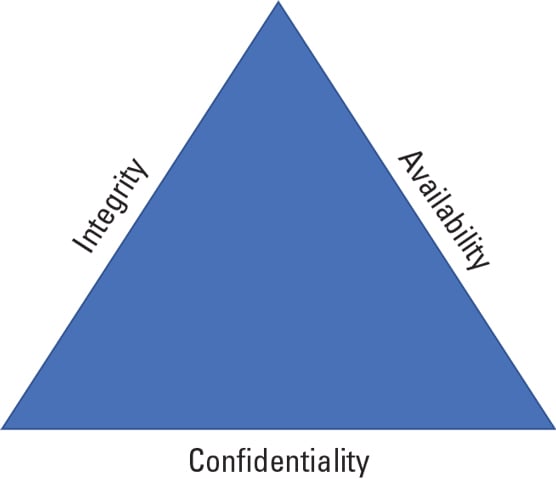The pillars of information security
Information security is the practice of protecting information by maintaining its confidentiality, integrity, and availability. These three principles form the pillars of information security, and they’re often referred to as the CIA triad. Although different types of data and systems may prioritize one over the others, the three principles work together and depend on each other to successfully secure your information. After all, you can’t have a triangle with two legs! The CIA triad is the foundation of information security.
The CIA triad is the foundation of information security.Confidentiality
Confidentiality entails limiting access to data to authorized users and systems. In other words, confidentiality prevents exposure of information to anyone who is not an intended party. If you receive a letter in the mail, the principle of confidentiality means that you’re the intended recipient of that letter; opening and reading someone else's letter violates the principle of confidentiality. The concept of confidentiality is closely related to the security best practice of least privilege, which asserts that access to information should only be granted on a need to know basis.In order to enforce the principle of least privilege and maintain confidentiality, it’s important that you classify (or categorize) data by its sensitivity level. Keep in mind that data classification plays a critical role in ensuring confidentiality. You must know what data you own and how sensitive it is before determining how to protect it and who to protect it from.
Privacy is a hot topic that focuses on the confidentiality of personal data. Personal information such as names, birthdates, addresses, and Social Security numbers are referred to as personally identifiable information (PII).
Integrity
Integrity maintains the accuracy, validity, and completeness of information and systems. It ensures that data is not tampered with by anyone other than an authorized party for an authorized purpose. If your mail carrier opens your mail, destroys the letter inside, and seals it back up — well, you have a pretty mean mail carrier! In addition to not being a very nice person, your mail carrier has violated the principle of integrity: The letter did not reach the intended audience (you) in the same state that the sender sent it.A checksum is a value derived from a piece of data that uniquely identifies that data and is used to detect changes that may have been introduced during storage or transmission. Checksums are generated based on cryptographic hashing algorithms and help you validate the integrity of data.
Availability
Availability is all about ensuring that authorized users can access required data when and where they need it. Availability is sometimes the forgotten little sibling of the principles mentioned in the two preceding sections, but it has a special place in the cloud given that easy access to data is often a major selling point for cloud services. If your letter gets lost in the mail, then availability is a clear issue — the message that was intended for you to read is no longer accessible for you to read.One of the most common attacks on availability is Distributed Denial of Service, or DDoS, which is a coordinated attack by multiple compromised machines causing disruption to a system’s availability. Aside from sophisticated cyber attacks, something as simple as accidentally deleting a file can compromise availability.
Availability is a major consideration for cloud systems.
Threats, vulnerabilities, and risks . . . oh my!
They aren’t lions, tigers, or bears — but for many security professionals, threats, vulnerabilities, and risks are just as scary. Threats, vulnerabilities, and risks are interrelated terms describing things that may compromise the pillars of information security for a given system or an asset (the thing you’re protecting).The field of risk management deals with identifying threats and vulnerabilities, and quantifying and addressing the risk associated with them. Being able to recognize threats, vulnerabilities, and risks is a critical skill for information security professionals. It’s important that you’re able to identify the things that may cause your systems and data harm in order to better plan, design, and implement protections against them.
Threats
A threat is anything capable of intentionally or accidentally compromising an asset’s security. Some examples of common threats include- A fire wipes out your datacenter
- A hacker gains access to your customer database
- An employee clicks a link in a phishing e-mail
Vulnerabilities
A vulnerability is a weakness or gap existing within a system; it’s something that, if not taken care of, may be exploited in order to compromise an asset’s confidentiality, integrity, or availability. Examples of vulnerabilities include- Faulty fire suppression system
- Unpatched software
- Lack of security awareness training for employees
Risks
Risk is the intersection of threat and vulnerability that defines the likelihood of a vulnerability being exploited (by a threat actor) and the impact should that exploit occur. In other words, risk is used to define the potential for damage or loss of an asset. Some examples of risks include- A fire wipes out your data center, making service unavailable for five days
- A hacker steals half of your customer’s credit card numbers, causing significant reputational damage for your company
- An attacker gains root privilege through a phishing email and steals your agency’s Top Secret defense intelligence
Risk = Threat x Vulnerability. This simple equation is the cornerstone of risk management.

